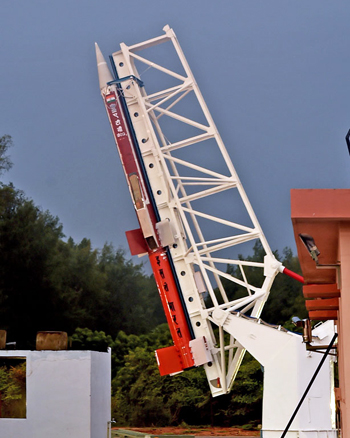INDIAN ARMED FORCES CHIEFS ON OUR RELENTLESS AND FOCUSED PUBLISHING EFFORTS

SP Guide Publications puts forth a well compiled articulation of issues, pursuits and accomplishments of the Indian Army, over the years

"Over the past 60 years, the growth of SP Guide Publications has mirrored the rising stature of Indian Navy. Its well-researched and informative magazines on Defence and Aerospace sector have served to shape an educated opinion of our military personnel, policy makers and the public alike. I wish SP's Publication team continued success, fair winds and following seas in all future endeavour!"

Since, its inception in 1964, SP Guide Publications has consistently demonstrated commitment to high-quality journalism in the aerospace and defence sectors, earning a well-deserved reputation as Asia's largest media house in this domain. I wish SP Guide Publications continued success in its pursuit of excellence.
Scramjet Success - ISRO Blitzkrieg’s Space
 |
By Lt. General P.C. Katoch (Retd) Former Director General of Information Systems, Indian Army |



It may be recalled that ISRO had to postpone its scramjet propulsion mission on July 23 on request of the military because the ill-fated AN-32 of the IAF flying from IAF Station Tambaram to Port Blair went missing the previous day and massive air and sea operations were put in effect. The scramjet propulsion mission was finally launched successfully on August 28. In so doing India joined the elite club of nations to successfully demonstrate flight testing of Scramjet Engine, others being the US, Russia and European Space Agency.
As per reports, after a 12 hour countdown, the solid rocket booster Advanced Technology Vehicle (ATV) carrying the Scramjet Engines lifted off at 6 am on August 28, and ended its 300-seconds flight by touching down in the Bay of Bengal, about 320 km from Sriharikota, ATV being a two-stage spin stabilized launcher with identical solid motors (based on Rohini RH560 sounding rocket) as the first as well as the second stage (booster and sustainer). The twin Scramjet engines were mounted on the back of the second stage. Once the second stage reached the desired conditions for engine ‘start-up’, necessary actions were initiated to ignite the Scramjet engines and they functioned for about five seconds, it said adding that Sunday’s ATV flight operations were based on a pre-programmed sequence. The vehicle was successfully tracked during its flight from the ground stations at Sriharikota. Scramjet stands for ‘Supersonic Combustion Ramjet’.
Rocket engines usually carry both fuel and oxidiser on board for combustion, but the Scramjet engine designed by the ISRO uses Hydrogen as fuel and the Oxygen from the atmospheric air as the oxidiser. Since these newly developed engines use oxygen from the atmosphere, it means reducing the lift-off mass of the vehicle as well as bringing down launch costs substantially. The Scramjet engine will also be used eventually to power ISRO’s reusable launch vehicle at hypersonic speed.
The spate of successes ISRO has achieved in recent years is phenomenal; from mission to the moon, to the mars, multiple launch of satellites to now the Scramjet Propulsion Engine. The latter itself, catapulting India to be the fourth country to do so in the world, entailed handling and developing critical technologies included: designing and development of the hypersonic engine air intake; developing the supersonic combustor; developing materials that could withstanding very high temperatures, efficient thermal management; tools for computing and to simulate the hypersonic flow; ensuring performance and operability of the engine across a wide range of flight speeds, and; ground testing of the engines. With this successful launch, ISRO has perfected the critical technologies of ignition of air breathing engines at supersonic speed, holding the flame at supersonic speed, air intake mechanism and fuel injection systems. Futuristic ISRO ventures include development of a reusable launch vehicle, human spaceflight, further lunar exploration, interplanetary probes, a solar spacecraft mission etc.
ISRO is already developing technologies that will allow it to transfer humans from one orbiting vehicle to another, immediate goal being enabling refueling of spacecraft to provide them with extended life and transfer other crucial systems to an existing spacecraft, by transporting another to space. Spacecraft docking will allow joining of two separate free-flying space vehicles. Another system called berthing will be used to transfer things from one vehicle to another. As per a senior ISRO scientist presently some ground simulations are being undertaken by ISRO, adding, “Favorable results will see us trying this with two small spacecraft launched for the purpose.” This can be used for orbit servicing of satellites. It will be a big capability boost since ISRO operates a huge constellation of satellites; a major advantage of such technology will give ISRO the ability to enhance lives of satellites by refueling them. Many Indian satellites like Astrosat with high-end technology on board can see their mission life extended once ISRO masters the technology of docking and orbital technology. The refueling could well be many times, without which missions would be over once onboard fuel is consumed. India is yet to become a member of the international space station or have a human space program but given ISRO’s dedication, it appears to be only a matter of time. Meanwhile, ISRO has bagged an order for launching 68 nano-satellites - 12 of them American. This will be a global first.
Photo Credit: ISRO





